How Recruiters Can Hire Smarter in Web3: From Proof-Based Screening to Global Pay Clarity
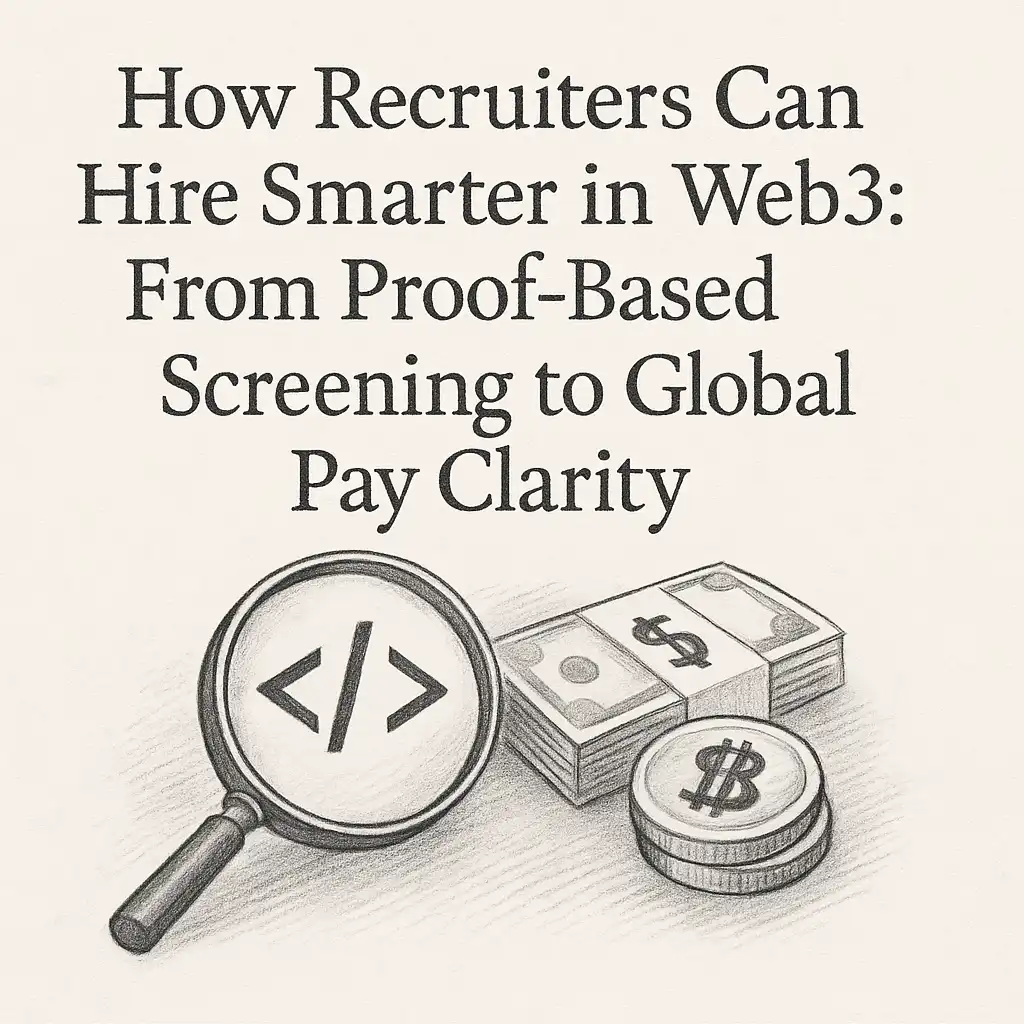
Blockchain hiring doesn’t fit old systems. Traditional recruiting frameworks — built for office-based teams, stable currencies, and predictable jurisdictions — weren’t designed for decentralized, tokenized, global work. In Web3 recruitment, a developer in Lagos, a designer in Lisbon, and a DAO contributor in Seoul may all work on the same project, yet get paid in different mixes of fiat and crypto.
This creates “signal misalignment.” Recruiters rely on résumés and degrees, while candidates present on-chain proof, GitHub commits, or DAO votes. Both sides talk about skills, but they measure them differently. That gap leads to mismatched expectations and missed opportunities.
The goal isn’t to replace traditional hiring — it’s to extend it. Recruiters can now use proof-based screening to verify skills through audits, pull requests, and verifiable contributions. Job descriptions can shift from listing tools to describing measurable outcomes. And compensation can blend fiat and tokens, transparently aligned with liquidity and vesting realities.
Cross border Compliance remains the quiet challenge — especially when contracts and crypto meet across borders. But with structured frameworks and clear communication, it’s manageable.
In emerging blockchain hubs like India, Singapore, and the UAE, recruiters are learning to balance compliance, hybrid pay, and proof-based hiring.
For context, read the discussions like
If you’re short on time, here’s a quick TL;DR on what’s changing in blockchain hiring and what recruiters should focus on first:
⚡ TL;DR
Key Takeaways for Recruiters Entering Web3 Hiring
Web3 recruitment is global, decentralized, and fast-changing — traditional hiring models struggle to keep up.
Focus on proof-based screening, not just résumés — verify GitHub commits, on-chain work, DAO participation, and project outcomes.
Understand token compensation and hybrid pay structures (fiat + tokens/stablecoins) to align incentives and manage volatility.
Manage cross-border web3 HR compliance early — clarify KYC/AML, contractor classification, and tax reporting across jurisdictions.
Write outcome-driven job descriptions that measure skills by results, not years of experience.
Build trust through transparent communication on total compensation, vesting schedules, and token liquidity.
Prioritize skills-based hiring — proof of delivery, audits, or governance activity outweigh formal degrees.
Recruiters who adapt their process for blockchain hiring attract stronger talent, improve retention, and future-proof their teams.
Resume Screening in a Decentralized World
Traditional résumé filters were built for stable industries — fixed job titles, formal education, and corporate hierarchies. In blockchain hiring, those signals often misfire. A candidate who’s contributed to a major open-source protocol may never have held a “senior engineer” title. Another might have audited multi-million-dollar smart contracts without a university degree.
That’s why résumé screening in Web3 needs a new lens: proof over pedigree. Recruiters aren’t just scanning keywords; they’re validating contributions that live on-chain or in code repositories.
Why Traditional Filters Fail
Automated tracking systems (ATS) can’t read GitHub pull requests or DAO governance records. They miss crucial performance evidence — commits, bug bounties, testnet deployments, audit reports. Traditional résumé screens assume centralized validation (titles, certificates), but Web3’s validation is decentralized and transparent.
Even experience summaries can mislead. Someone listing “Solidity developer, 3 years” might have cloned tutorials, while another with fewer years may have authored verified contracts used in live DeFi products.
Recruiters who rely only on text-based résumés risk rejecting the latter — the one with real proof.
Checklist: Recruiter’s View — Proof-Based Screening
Use this as your starting point:
✅ Look for verifiable public work — GitHub repos, Etherscan links, testnet deployments.
✅ Ask for evidence of collaboration — DAO governance, contributor records, hackathon projects.
✅ Validate audit trails — bug bounties, protocol reviews, or open-source merges.
✅ Prefer problem-solving narratives over tool lists.
✅ Review consistency between résumé claims and on-chain history.
✅ Use structured templates to record proof sources (e.g., repository link + commit date + contribution summary).
✅ Check community reputation where possible (verified handles, project contributor badges).
Recruiters can learn more in our discussion threads
GitHub matters in blockchain hiring
How candidates should present work to impress recruiters
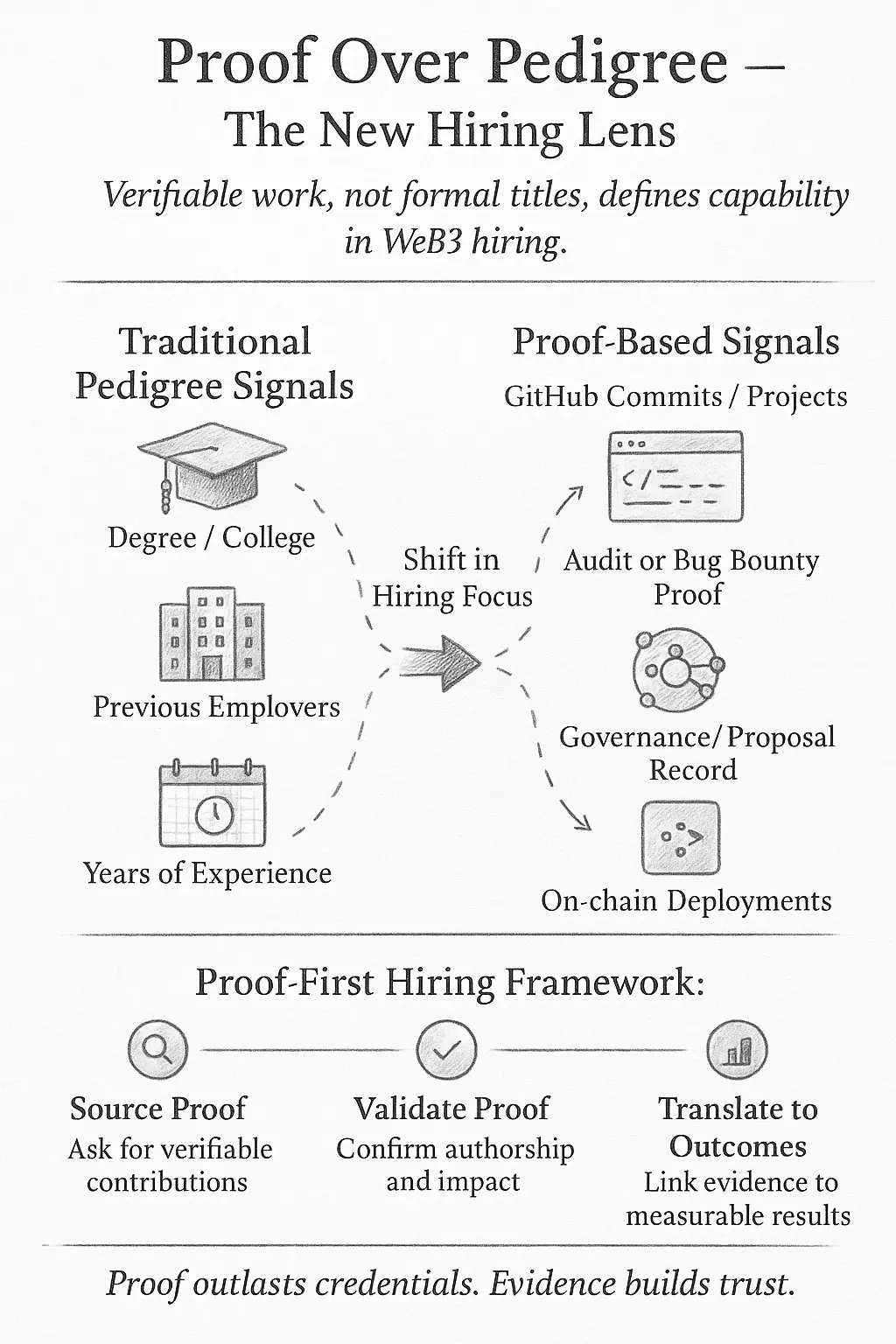
Checklist: Candidate’s View — How to Be Screen-Ready
When evaluating candidates, encourage them to present proof like this:
🔹 Link GitHub and project contributions in résumés.
🔹 Summarize why a contribution mattered — not just what tool was used.
🔹 Add DAO proposals or governance votes that show community impact.
🔹 Include bug reports, audits, or bounty submissions as evidence of applied skills.
🔹 Keep links updated; recruiters will verify.
🔹 Use cover letters to explain outcomes briefly
Read our internal resource How to write a Web3 cover letter
Encouraging this transparency improves trust. Recruiters can quickly verify proof without relying on inflated job titles.
DAO Experience: The New Reference Check
DAO contributions act as a live résumé — timestamped, transparent, and verifiable. They demonstrate initiative, collaboration, and governance literacy. Recruiters evaluating DAO work should assess:
Number and type of proposals authored or supported.
Engagement quality in discussions and community calls.
Measurable impact of the contribution (feature merged, proposal funded, issue resolved).
See How to show DAO experience on a résumé
Proof-Based Interview Questions
During interviews, shift from hypothetical to evidence-based.
Ask:
“Which contract or repo best represents your problem-solving style?”
“What’s your most recent on-chain contribution, and what outcome did it achieve?”
“If you could refactor one of your own commits, what would you improve?”
These questions replace buzzword screens with behavior-based insights.
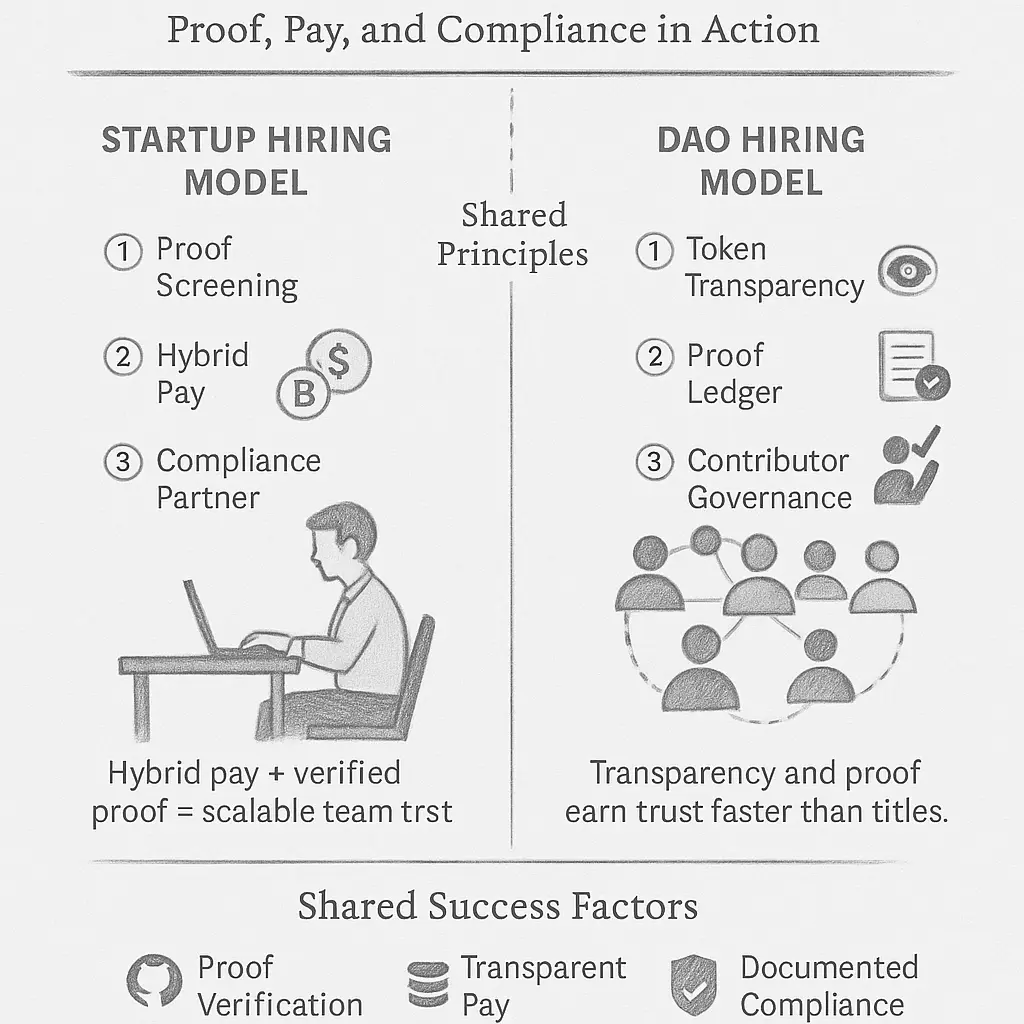
JD Tune-Up for Web3 Roles
Most blockchain job descriptions still read like Web2 templates: “3–5 years’ experience,” “Bachelor’s degree preferred,” and “familiar with Ethereum.” These phrases filter out talent instead of clarifying outcomes.
A modern Web3 job description defines what success looks like, not just the tools used.
Before (Typical JD Excerpt)
“Seeking Solidity Developer with 3+ years’ experience. Must know React, Node.js, and Truffle. Prior blockchain exposure required.”
After (Outcome-Based JD)
“Seeking Smart Contract Engineer to design, deploy, and maintain token contracts supporting X protocol. Success is measured by security audit results, deployment uptime, and gas optimization improvements. Bonus if you’ve contributed to open-source DeFi tools or on-chain governance.”
The difference: The second version attracts contributors who think in results, not checklists.
JD Tune-Up Checklist
🎯 Define outcomes, not years of experience.
⚙️ Mention protocols and stack contextually (why they matter to your system).
💬 Add proof expectations (“Share GitHub or testnet links”).
🪙 If compensation includes tokens, clarify structure early
🌐 Keep language inclusive for global contributors.
When recruiters apply this lens, they attract builders, not buzzword chasers.
🔹 Recruiter Starting Point — Learning Blockchain Without Drowning in Jargon
A recruiter new to blockchain recently summed up a common challenge:
“How do I tell a good blockchain developer from an average one if I’m not technical yet?”
It’s a fair question — and one many HR professionals face when stepping into Web3 recruitment.
Here’s a practical path to get started confidently:
Learn the ecosystem, not the code.
You don’t need to master Solidity or cryptography. Begin with understanding the main role types — developers, auditors, product leads, compliance analysts, and business developers.
→ For a quick primer, read our discussion “What Web3 basics candidates often miss”Anchor on “proof,” not “pitch.”
Ask candidates for tangible evidence — GitHub commits, on-chain deployments, or audit mentions.
For non-technical roles, proof can mean measurable project outcomes —successful pilots, strategic partnerships, or adoption metrics that demonstrate blockchain’s real impact.Use the “Explain It Back” Test.
During interviews, ask: “Can you explain what problem your blockchain solution solved in plain English?”
Skilled candidates connect technology to business value. Average ones often can’t bridge that gap.Curate a Recruiter’s Watchlist.
Follow a handful of credible resources — community discussions, foundation blogs, or technical explainers — for 10–15 minutes weekly. Over time, you’ll develop intuition about common tools, protocols, and jargon.
This approach helps recruiters evaluate depth and relevance without becoming engineers — and builds confidence when screening both technical and hybrid blockchain roles.
Pay Structures Beyond Fiat — Making Sense of Token + Stablecoin Mix
In Web3 recruitment, compensation isn’t just a paycheck — it’s a portfolio. Traditional salaries can’t capture the full picture when projects use a mix of fiat, tokens, and stablecoins to pay contributors worldwide.
Recruiters now need fluency in token compensation, stablecoin payroll, and hybrid pay models. Understanding how these models work helps set realistic expectations on both sides and avoids legal or financial misunderstandings later.
Let’s break it down.
Model 1: Fiat-Only (Conventional, but Safe)
Many early-stage Web3 startups still pay in fiat, especially for compliance or predictability. This works well for:
Full-time employees under a legal entity.
Roles where contracts and benefits require local taxation.
Candidates who prefer stable national currency income.
However, this model may limit upside participation. Contributors often want exposure to the project’s native token or governance system. Pure fiat pay can feel disconnected from project growth.
Fiat-only is safest for HR compliance but least aligned with Web3’s ownership ethos.
Model 2: Hybrid Pay (Most Common in Web3)
A hybrid model mixes fiat (for stability) and tokens or stablecoins (for upside or flexibility). It’s now the norm for many remote teams.
Typical split:
60–80% fiat (salary equivalent).
20–40% tokens or stablecoins (vesting or liquid).
This model balances predictability and participation. Tokens give contributors skin in the game; fiat keeps them secure.
When explaining hybrid pay, recruiters should define:
Cliff: The minimum time before any tokens are released (often 6–12 months).
Vesting Schedule: How tokens unlock over time (e.g., monthly over 2 years).
Liquidity: Whether tokens are immediately tradable or subject to lock-up.
Clear definitions prevent confusion — and potential disputes — later.
Candidates often worry about volatility and cash flow. You can read an interesting discussion and really a hot topic in AOB.
Handling stablecoin pay — real concerns from candidates for real-world insights into how others manage the risk.
Model 3: Token-Only (Aligned but Risky)
Token-only compensation is common in DAOs or community projects without a legal entity. It aligns incentives perfectly — everyone owns a share of the network they build.
But there are tradeoffs:
Tokens may be illiquid or locked for months.
Taxation varies by jurisdiction and can be complex.
Value may fluctuate sharply between contract signing and payout.
Token-only roles work best for contributors who understand blockchain economics and can tolerate risk. Recruiters should disclose token details transparently and recommend candidates consult a qualified tax advisor for local obligations.
For insights on valuation and market perception, read our discussion threads
Developer salary — skills that matter
Understanding Token Valuation
For recruiters and HR leads, token valuation basics include:
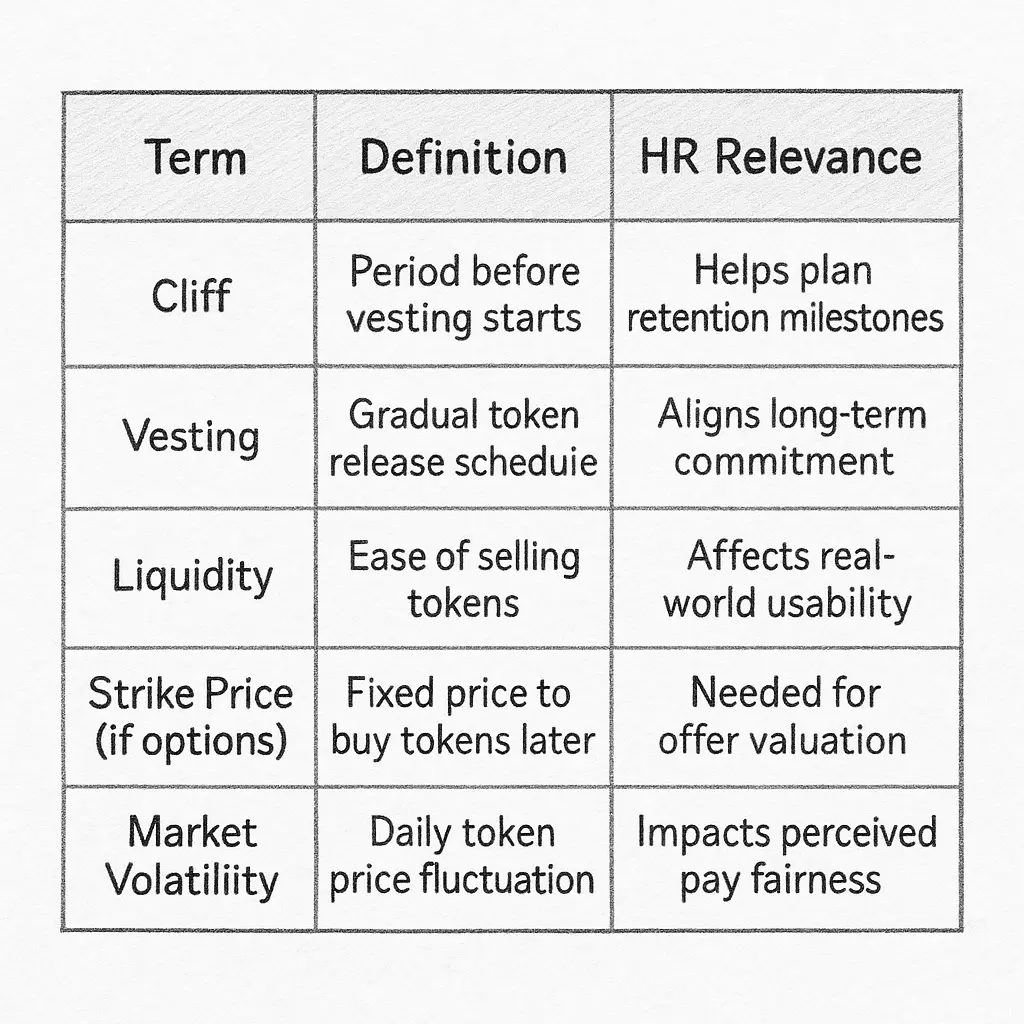
Total Compensation — Plain-English Example
Scenario:
You’re hiring a smart contract engineer for $100,000 total annual comp.
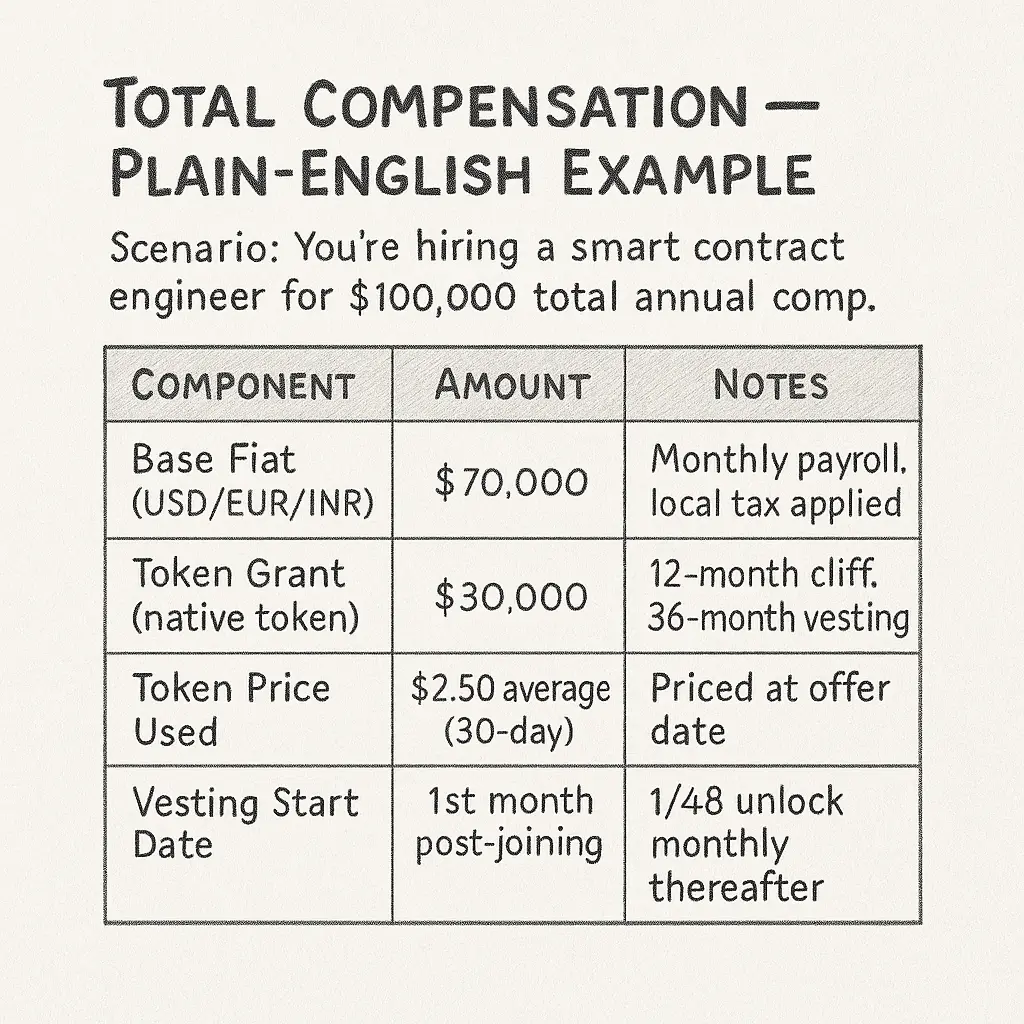
By separating cash flow and token flow, recruiters can manage expectations clearly.
Transparency Checklist for Recruiters
Use this quick checklist when making hybrid or token-based offers:
✅ Disclose token vesting and liquidity (include cliff and schedule).
✅ Specify valuation basis — spot or 30-day average.
✅ Include stablecoin type and network (e.g., USDC on Ethereum).
✅ Outline tax responsibility (“Consult a qualified advisor for local compliance”).
✅ Document pay structure in writing (smart contracts optional, but HR-verified agreements preferred).
✅ Address geographic variations — pay fairness matters.
On that last point, explore
Geographic pay gap in remote Web3 jobs
Recruiters who build transparency into compensation in web3 hiring frameworks reduce churn and build long-term trust — a key differentiator in decentralized ecosystems.
Compliance & Cross-Border Hiring: The Hidden Bottleneck
Global blockchain teams operate beyond borders — but laws don’t. When compensation includes tokens or stablecoins, the compliance challenge multiplies. Every jurisdiction treats crypto differently, and HR teams must balance innovation with accountability.
That tension is the hidden bottleneck of Web3 recruitment: teams hire globally, but payroll, tax, and employment laws remain local.
Engagement Models in Web3 Hiring
Most blockchain organizations use one of three models — each with tradeoffs in compliance risk, flexibility, and contributor trust.
1. Employee (Local Entity Model)
Standard payroll, taxes, and benefits apply.
Works best for regions where the startup is registered.
Offers maximum legal clarity and social protection.
Limit: Expensive for global teams; requires entity setup per country.
2. Contractor (Freelancer Model)
Common for remote-first startups and DAOs.
Paid in fiat, stablecoins, or tokens against invoices.
Flexible but needs compliant classification — not all jurisdictions allow contractors with “employee-like” schedules.
Recruiters should clarify deliverables, avoid control-heavy agreements, and note “independent contractor” explicitly.
See Contractor vs employee in Web3for deeper analysis.
3. Contributor (DAO or Tokenized Model)
Operates through wallets, not contracts.
Paid in tokens, with rewards often governed by community votes.
Legal recognition varies — DAO contributors are sometimes classified as volunteers or partners.
Works well for open-source collaboration, but recruiters must verify contributor KYC if payments exceed local reporting thresholds.
Each model demands different record-keeping, tax documentation, and risk assessments.
Crypto Payroll Compliance — Where It Gets Complex
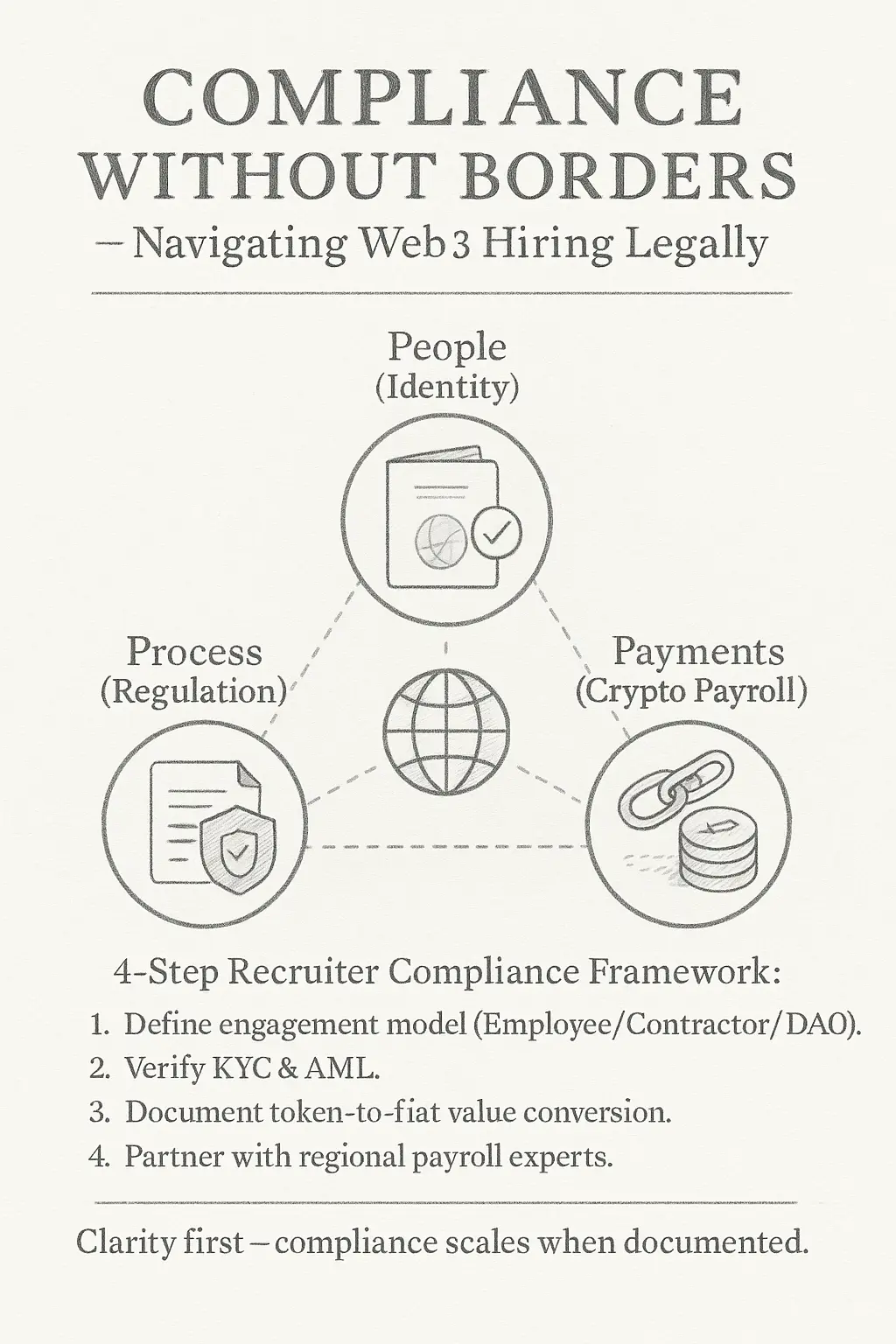
Crypto payroll isn’t inherently illegal, but it’s rarely straightforward.
HR teams must manage reporting, withholding, and identity verification in systems originally built for fiat.
Key considerations:
Taxation: Crypto is often treated as property or income, depending on jurisdiction. Recruiters should clarify who bears reporting duty — employer or contributor.
KYC/AML: Most payroll providers require contributor verification (passport, address proof). Using anonymous wallets for payment can trigger AML concerns.
Transaction Records: Retain transaction hashes as payment evidence — auditors accept these as digital receipts in many countries.
Conversion Reporting: When tokens are sold for fiat, capital gains may apply. Always advise contributors to consult a qualified tax advisor before filing.
For reference, see
Crypto compliance analyst — where to start
Blockchain compliance careers overview
Cross-Border Contracting — Practical Pitfalls
Recruiters managing remote Web3 teams face these recurring challenges:
🌍 Jurisdiction mismatch: Employer in Singapore, contributor in Argentina — whose laws govern the contract?
💸 Crypto conversion timing: Token prices change between invoice and payout; use a 7- or 30-day average to avoid disputes.
📑 Tax registration: Some countries require contractors earning in crypto to declare income in local currency equivalents.
🧾 Reporting thresholds: Cross-border payments above a limit may need FATCA, CRS, or travel rule declarations.
🪙 Wallet identity: Anonymous or multi-sig wallets complicate payroll documentation.
To simplify, recruiters can use crypto payroll intermediaries or registered Employer of Record (EOR) partners for high-risk jurisdictions.
Time Zones and Team Operations
Compliance also extends to how remote contributors collaborate. Overlapping time zones and varied labor laws affect productivity and work classification.
Recruiters can proactively manage this using clear documentation of deliverables and working hours — a best practice discussed in Managing time zones in remote teams
Action Plan Checklist: Recruiters’ 4-Step Compliance Framework
Step 1: Map Engagement Type
Identify each contributor’s status (employee, contractor, or DAO).
Record payment flow: fiat, stablecoin, or token.
Step 2: Verify KYC/AML Compliance
Collect IDs for all paid contributors.
Store on-chain payment proof securely.
Step 3: Document Tax and Conversion Data
Convert token values using average price benchmarks.
Keep detailed transaction logs for audit support.
Step 4: Partner Strategically
Engage regional payroll or EOR services for complex jurisdictions.
Offer contributors guidance to seek local tax advice.
This framework balances decentralization with due diligence — helping recruiters scale safely.
Compliance Caveat:
This content is informational only. It’s not legal, tax, or financial advice. Recruiters should always consult a qualified advisor before implementing cross-border or crypto payroll systems.
Proof > Pedigree — The Skills-Based Future of Web3 Hiring
In Web3 recruitment, degrees and job titles no longer guarantee competence. Real impact shows up in code, commits, and contributions — all publicly verifiable. The shift toward proof-based hiring is one of the most profound changes in talent evaluation since the rise of digital portfolios.
Recruiters now have access to more transparent skill signals than ever: GitHub histories, smart-contract audits, DAO governance records, and on-chain transaction logs. These create a verifiable picture of a candidate’s ability to ship, collaborate, and deliver results.
Why Proof Beats Pedigree
Traditional credentials — university degrees, certifications, or years of experience — are proxies for ability. Proof, on the other hand, is direct evidence of it.
For example:
A candidate’s audit contributions on GitHub show secure coding practices.
A bug bounty submission demonstrates real-world testing and risk management.
A DAO proposal highlights governance participation and understanding of decentralized systems.
Recruiters can view these proofs in real time. The transparency reduces guesswork, improves diversity, and helps spot genuine builders who may have been filtered out by traditional ATS systems.
See
Projects that help juniors land jobs for deeper examples.
The Proof-First Hiring Framework (3 Steps)
Use this structured, repeatable process for evidence-based evaluation:
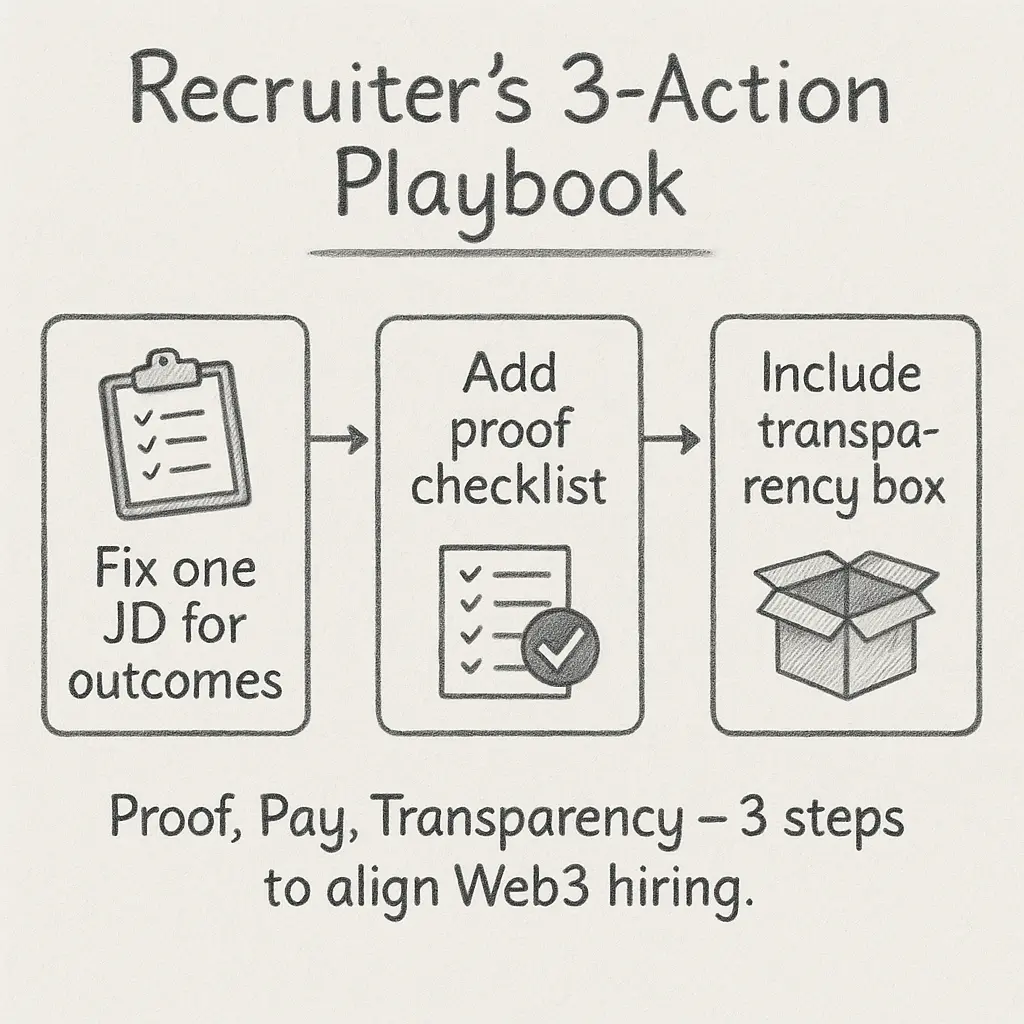
Step 1 — Source Proof
Ask candidates for:
GitHub or GitLab links (public or private).
On-chain records (testnet/mainnet contracts).
DAO proposals or community contribution logs.
Audit reports, bug bounties, or security disclosures.
Step 2 — Validate Proof
Confirm authorship (username, wallet, commit email).
Assess context — was it solo work, a team project, or open-source contribution?
Review peer feedback, PR comments, or governance votes for collaboration quality.
Step 3 — Translate Proof to Outcomes
Connect each artifact to measurable results (e.g., reduced gas cost by 15%, fixed protocol exploit).
Record proof summary in the candidate profile for future reference.
Recruiters using this framework can confidently justify shortlists and pay offers using verifiable evidence, not assumptions.
Proof Artifacts: What to Look For
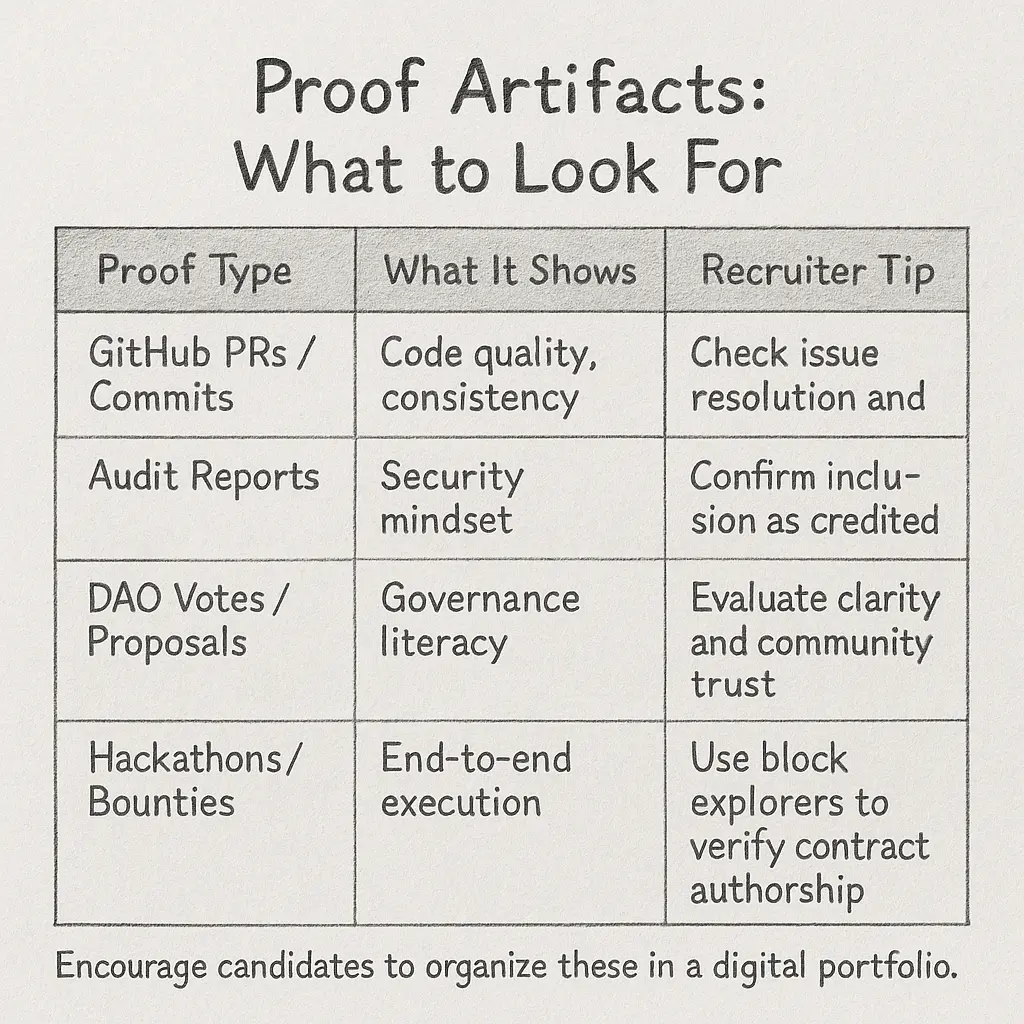
Proof Over Pedigree Benefits
For Recruiters: Cuts noise, improves confidence in shortlists.
For Founders: Aligns hiring with the product’s open-source values.
For Candidates: Levels the playing field — contribution matters more than credentials.
Proof-based systems help recruiters see the real builders, not just résumé polishers.
Hiring Tools, Tests, and Trends in Blockchain Recruitment
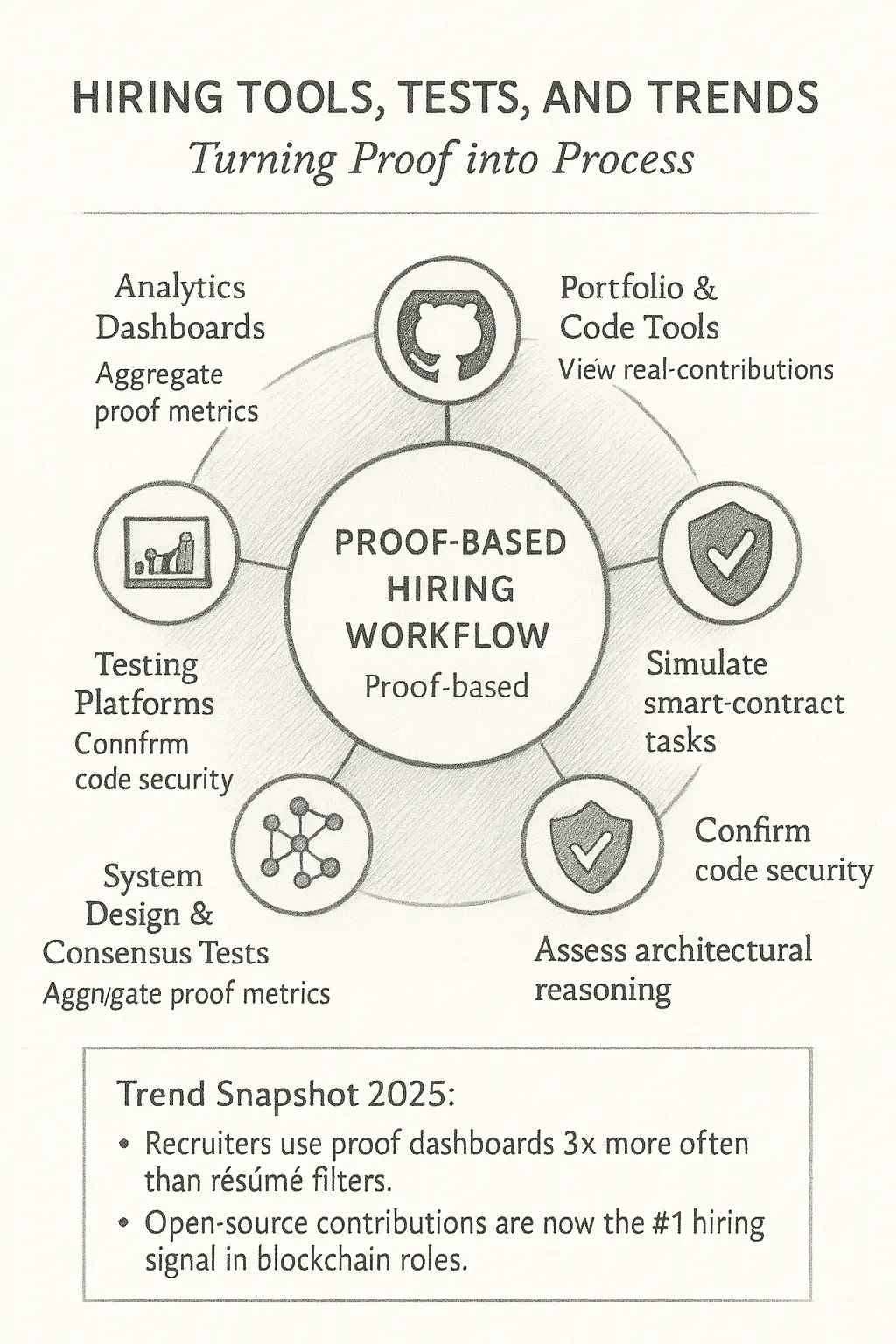
As Web3 grows, recruiters need structured, verifiable tools to evaluate skills across continents. Manual review of repositories and DAOs doesn’t scale — automation and standardized testing now bridge that gap.
Here are the key categories of modern Web3 assessment tools:
1. Technical Skill Platforms
These simulate live blockchain environments where candidates can:
Write and deploy smart contracts safely.
Solve gas optimization problems.
Debug Solidity or Rust challenges in real-time.
Some tools even integrate on-chain verification — storing test completions publicly for transparency.
For developer prep insights, have a look at
2. Audit and Security Assessments
Security remains central to blockchain hiring. Recruiters can evaluate candidates by reviewing past audit reports or offering small test audits of sample contracts.
Encourage candidates to show their work through public audits or bug bounty submissions.
For context, AOB discussion
Best resources for smart-contract testing
3. System Design & Consensus Thinking
Beyond coding, blockchain engineers must understand system trade-offs — scalability, decentralization, and consensus mechanisms.
Recruiters can use scenario-based questions to test architectural reasoning:
“How would you design a cross-chain bridge minimizing MEV risk?”
“What trade-offs exist between PoS and PoA in governance-heavy DAOs?”
See System-design for consensus interviewsfor related prep.
4. Portfolio Analytics Tools
New HR dashboards now aggregate candidate GitHub metrics, contribution streaks, and DAO engagement into structured profiles.
These tools help recruiters compare candidates fairly without relying on manual verification.
Example features include:
Repo quality scoring (tests, docs, linting).
Tokenized reputation badges from DAOs.
API integrations with blockchain explorers for real-time proof validation.
This shift from résumé-driven to data-driven hiring is transforming recruitment efficiency across Web3 startups.
5. Continuous Learning & Proof Stacking
Encourage candidates to treat every hackathon, bounty, or open-source contribution as portfolio currency. Recruiters can maintain a “proof stack” in their ATS — linking verified artifacts directly to interview stages.
This approach helps new entrants stand out.
Read Projects that help juniors land jobsfor examples of effective beginner portfolios.
What Works: Two Mini Case Studies (Startup + DAO)
Case Study 1 — Startup: Hybrid Pay + Proof-Based Screening
A mid-stage DeFi startup in Singapore wanted to expand its engineering team globally. Traditional recruiting pipelines produced impressive résumés — but weak delivery. The team pivoted to a proof-first approach: they screened GitHub repos and verified on-chain deployments before any interviews.
They replaced degree filters with evidence-based checklists:
Minimum three verified PRs to open-source repos.
One production-level smart contract or audit contribution.
Active participation in one blockchain community forum.
Candidates shared links and summaries; HR validated each in less than 15 minutes. This change cut early screening time by 40% and boosted offer acceptance by 25%.
The company adopted a hybrid pay model — 70% fiat, 30% token grant vesting quarterly — for fairness and alignment. Recruiters also standardized pay disclosure using a “Total Comp Box” in every JD.
Outcome: a distributed team across four continents, fully compliant through a remote payroll partner, and 0% attrition in the first six months.
Case Study 2 — DAO: Contributor Recognition + Transparency Wins
A governance-focused DAO struggled to attract experienced contributors. Applicants often felt uncertain about pay rates and token value. The DAO introduced a transparent compensation dashboard listing roles, vesting periods, and average monthly token equivalents.
They also implemented a proof ledger — contributors logged verified actions (proposal votes, merges, audits) that auto-updated their portfolio.
This boosted trust, improved peer validation, and helped the DAO onboard 50+ verified contributors from 12 countries.
The takeaway: proof transparency builds credibility faster than any credential ever could.
For related insights, read AOB discussions like see
Questions to ask in a blockchain interview
Remote blockchain jobs — are they really remote?
FAQs (6–8 Q&As, 40–70 words each)
1. How should recruiters evaluate blockchain candidates without deep technical knowledge?
Focus on proof artifacts: GitHub commits, audit credits, and on-chain records. You don’t need to read code — just confirm public contribution links and consistency between claims and artifacts.
2. Is paying in tokens or stablecoins legally safe?
It depends on jurisdiction. Many teams use hybrid pay (fiat + token) to balance compliance and upside. Always disclose valuation methods and advise contributors to consult a qualified advisor for tax implications.
Salary expectations — candidate view
3. How do recruiters verify DAO experience?
Request contributor dashboards or governance profiles showing proposals, votes, or merges. DAO activity is timestamped and public — making verification easier than in traditional orgs.
4. Are global blockchain jobs truly remote?
Mostly yes, but time zones and compliance affect feasibility. Some DAOs are fully async; others require overlapping hours.
Check Remote blockchain jobs — are they really remote?
5. How do startups handle geo pay gaps for token-based roles?
Use transparent compensation tables by region and liquidity-adjusted token value. Hybrid pay helps smooth differences.
6. Should recruiters still ask for formal education in Web3?
Only if it directly relates to cryptography, computer science, or law. Practical proofs — commits, audits, proposals — should weigh more heavily than degrees.
7. What’s the best way to onboard non-technical roles in Web3?
Create role-specific proof paths: content samples, community management metrics, or on-chain moderation history. Everyone can show outcomes — not just coders.
8. How should founders transition their teams from Web2 to Web3 hiring practices?
Start by aligning hiring metrics to verifiable output. Reduce reliance on tenure, add proof-check boxes in interviews, and integrate transparent token compensation.
9: I’m new to blockchain recruitment. How can I learn enough to spot strong candidates?
Start by learning role categories and core terminology. You don’t need to code — focus on proof. Ask for visible work like GitHub commits, testnet deployments, or measurable project outcomes. Strong candidates explain blockchain impact clearly; weaker ones rely on jargon.
Conclusion
Web3 hiring is evolving from paper credentials to transparent, verifiable proof. Recruiters who adapt — by validating evidence, standardizing hybrid pay, and documenting compliance — build trust and resilience across global, decentralized teams.
The tools are here. The frameworks are mature. What’s needed now is consistency — structured screening, outcome-based job descriptions, and transparent pay.
At ArtofBlockchain, we help recruiters, HR teams, and founders move from uncertainty to clarity — aligning proof, pay, and compliance in a decentralized world.